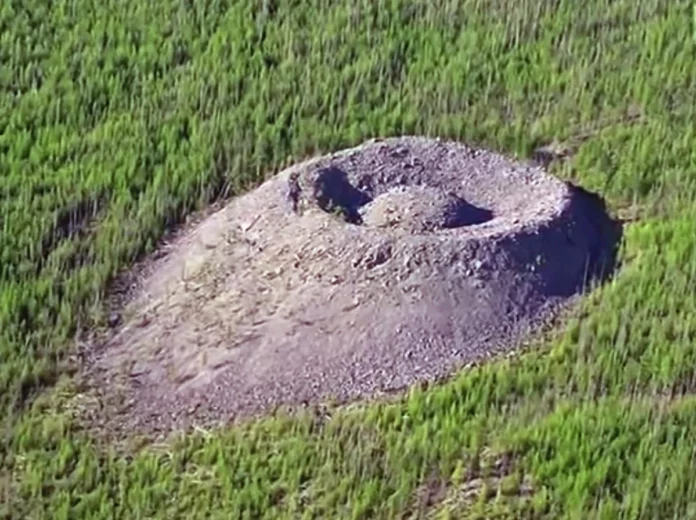The Patomskiy Crater is one of the most mysterious geological formations in the world. Located in the Irkutsk region, in the Bodaysky district, the crater doesn’t resemble a typical hole in the ground; instead, it looks like a low hill with a circular depression at the top. Surprisingly, despite numerous studies conducted by geologists, biologists, and petrographers, the formation of the Patomskiy Crater remains a mystery to this day…
Discovery History and Origin Hypotheses
The crater was discovered over half a century ago by Irkutsk geologist Vadim Kolpakov. The researcher described an object shaped like a cone with a diameter of 150 meters. At the top of the “cone” was a “dome” surrounded by crater walls. Such structures had not been observed by geologists before. The discoverer proposed a hypothesis that the crater formed as a result of a meteorite impact.
In 1963, an expedition from the Academy of Sciences was sent to the crater to uncover the mystery of its formation. Scientists concluded that it could have only appeared as a result of the impact of an extremely durable meteorite on the planet’s surface. Its strength had to exceed by many times the strength of all meteorites that had ever collided with Earth.
Renowned geologist Sergey Vladimirovich Obruchev refuted the “celestial” hypothesis of the crater’s origin. He was convinced that it appeared due to the breakthrough from the depths of the planet of a jet of gas mixed with steam.
There are more exotic theories about the origin of the Patomskiy Crater. According to some researchers, it formed as a result of tests of Soviet mysterious superweapons, possibly a new modification of a nuclear bomb that never went into mass production.
Ufologists naturally take the blanket on themselves and claim that the crater appeared as a result of the crash of a spaceship.
Some even believe that the crater was deliberately built during the Stalinist terror by political prisoners. However, no one knows the purpose behind it.
Artificial Construction or Nature’s Whim?
Vadim Kolpakov, who first described the Patomskiy Crater, wrote that upon seeing the unusual “hill,” he initially thought he had gone mad from the heat. At first, he thought the crater was man-made. However, the Evenks and Yakuts, who inhabit the area where the crater was found, never built such “monuments.”
After some time, Kolpakov managed to discuss his find with the locals. The Yakuts said they called the crater the “Nest of the Fire Eagle.” They also revealed that they preferred not to approach the crater too closely because both people and animals felt uncomfortable in its vicinity.
By the way, in 2005, during an expedition to the crater, a man indeed died. According to eyewitnesses, one of the employees of the Irkutsk Institute of Geochemistry, approaching the remarkable object, fell on the trail and wheezed. The first aid provided by his companions did not yield any results. Later, it turned out that the geologist died from a massive heart attack. And some concluded that this was not a simple coincidence: the researcher became one of the victims of the “Fire Eagle.”
When Did the Crater Appear?
The age of the crater was determined quite accurately using larch trees that grew on its top. It turned out that the oldest larch tree grew on the crater 230 years ago. According to geologists, for a tree to start growing, it needs wind to bring some soil onto the rocks.
So, adding 20-25 years to the 230 years, the Patomskiy Crater formed around 250 years ago. Unfortunately, at that time, there were no people living in the area where the crater is located. And even if it formed as a result of the fall of a large bolide to Earth, there simply cannot be any evidence of it.
Thanks to the fairly accurate determination of the crater’s age, one of the versions of its origin was refuted: some scientists believed that the unusual object was directly related to the fall of the Tunguska meteorite.
What’s Beneath the Crater?
Geologists attempted to determine what lies beneath the crater. This was facilitated by a modern method called magnetometry. The crater is located in an area where iron ores are relatively rare. Therefore, even a slight increase in the concentration of ferromagnetics in the soil can be easily detected by special devices.
It turned out that beneath the crater, there is indeed an elevated content of iron or other substances with ferromagnetic properties. Moreover, the increase in concentration is detected in an area twice the diameter of the crater. What exactly lies underground? Remnants of the meteorite that fell to Earth two and a half centuries ago? A spaceship from extraterrestrial beings? No one can definitively answer these questions yet.
The Patomskiy Crater is a unique structure. There is nothing else like it anywhere else in the world. Despite being discovered over half a century ago, scientists still haven’t reached a consensus regarding its nature.
